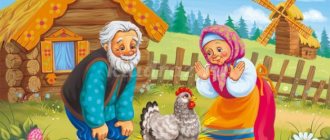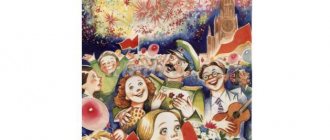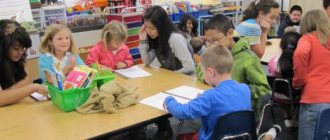Open demonstration of the walk “Treasure Hunters” in the preparatory group
Exercise:
There are fallen trees ahead (gymnastic poles 3 pieces, racks 6 pieces), you need to raise your legs high and step over them without hitting them. Don't push each other! Well done, everyone did it! Children approach the spruce tree, there is an Owl on the tree. And here comes the Owl!
Hush, guys, don't make any noise, the Wise Owl is sleeping. I don’t understand what it is. It's daytime outside, but the Owl is sleeping? Why? Children's answers
owls fly at night, catch mice, and sleep during the day. But the Wise Owl has not forgotten about you guys. She left you a letter and a map. Let's read the letter: “Dear guys, to find the treasure, you need to follow the route indicated by the arrow on the map and complete all the tasks. After each correctly completed task you will receive one part of the cut picture. By collecting all the parts of this picture, you will find out where the treasure is hidden. I wish you success! Wise Owl".
Teacher:
Let's look at the map, you and I must go through all the points on the map, let's start from the first.
1st point of the Route – “Forest mysteries”
I'm reading a riddle:
“This tree blooms, gives aroma and honey. And it saves us from the flu, And it’s called... (Linden)
- Let's find words suitable for linden? What is she like? (beautiful, powerful, fragrant, honey-bearing)
Teacher
: Who knows the beneficial properties of linden? Linden is a valuable tree. Linden flowers contain a lot of sweet nectar, from which honey is obtained. Linden honey is fragrant and healthy.
-What did they say about the linden tree in the old days? “The linden tree puts shoes on people, feeds them and gives them water.” They wove paws from linden bark, brewed tea with linden blossom, and ate delicious honey. Which one of you will tell a poem about the linden tree?
“I love to walk in the linden alley,
The leaf will turn yellow and fall under the bench.
It means autumn is coming, I hear rustling, creaking,
Like the conversations of dark-trunked linden trees.
And that winter is coming soon,
Snowy mountains are like a tower.” (Julia V)
Teacher:
Well done, children, you have successfully completed the beginning of the journey.
And here is the first part of the cut picture (glued behind the linden tree).
But we cannot stop, we must continue our journey. What does the map show us?
2 Route point - “Sharpshooter”
Teacher:
On the road, guys, it is very important to be prepared for any difficulties, which means to be an accurate hunter.
Assignment:
Guys, each of you needs to hit the target. Distribute the balloons to the children. Get into two teams: boys and girls.
Children throw sticky balls at a target.
Teacher:
Well done!
And you completed this task. Keep the second part of the cut picture !
We continue to navigate using our map. (Children look at the map and determine the further path).
Route 3: “Help the forest dwellers”
Teacher:
Let's form 2 teams.
At the signal, you need to fill the baskets with cones, take one cone at a time. Well done! We collected a lot of cones for the squirrels, now they are not afraid of any frost! And here is the third part of the picture (at the bottom of the basket)
. Let's look further at the map!
Summary of the walk “Observations in the garden in autumn”
Alla Yuryevna Kotova
Summary of the walk “Observations in the garden in autumn”
Purpose of the walk : To form in children generalized ideas about vegetables (vegetables are the succulent parts of herbaceous plants that people grow in the garden for food); to clarify the names of vegetables in children, the differences from each other in shape and color.
Take your children on an excursion to the vegetable garden . Note that most of the beds are already empty; the ripened harvest of vegetables has been harvested from them.
Ask the children what time of year it is ( autumn )
How do people prepare for winter?
(harvest ripe vegetables, dig up beds before winter)
What do people store for the winter
(vegetables, fruits, everything that grew in
the garden ) . To note with the children that cabbage has grown in our garden bed, this can be seen from the formed cabbages. Offer to remove the cabbage and take it to the kitchen to the cooks.
Ask the children what dishes can be prepared from cabbage: borscht, cabbage rolls, vegetable stew. Together with the children, take the ripened root vegetables to the garden food service.
Sayings and proverbs: in September it’s cool, but it’s nourishing; in September, even a leaf on a tree doesn’t stick; Father September is cold, but there’s a lot to feed; September doesn’t exist without fruits.
Didactic game “What grows in the garden ?”
Goal: to teach children to classify objects according to certain characteristics (by their place of growth, by their use, to develop quick thinking.
Outdoor game "Hares and wolves".
THANK YOU FOR YOUR ATTENTION!
Summary of observing wild grapes in the fall with children of the preparatory group for school. On the territory of the kindergarten there are many deciduous and coniferous trees, shrubs, and herbaceous plants. Among this plant. Summary of the walk “Observation and participation in planting seedlings in the garden” Summary of the walk “Observation and participation in planting seedlings in the garden.” Goal: to form a system of ideas about growth and development in children. Summary of the walk “Observing the planting of vegetable crops in the garden” Purpose of the walk: To observe with children the young shoots of vegetable plants and herbs; Please note that not all plants are in the garden. Summary of the walk “Observing the watering of plants in the vegetable garden and flower garden” Purpose of the walk: To teach children to conserve tap water, to teach them not to pour water unnecessarily; to note the great importance of proper watering of plants, especially. Summary of the walk “Observing seedlings in the garden after the rain” Purpose of the walk: to teach children to establish a connection between the state of the plant and the conditions in which it is located, caring for it; form. Summary of the walk “Observing seedlings in the garden after rain or watering” Purpose of the walk: To teach children to establish a connection between the state of plants and the conditions in which it is located, caring for them; form.
Source
Summary of the walk in the senior group “Autumn Walk”
Elena Turavina
Summary of the walk in the senior group “Autumn Walk”
Goal: To generalize and consolidate children’s knowledge about the main signs of autumn, vegetables and fruits.
Tasks:
Educational:
clarifying and expanding children’s knowledge about the autumn season, vegetables and fruits,
expansion and activation of children's vocabulary;
improving the ability to listen carefully and answer questions;
formation in children of a generalized idea of trees in the autumn.
Educational:
development of children's cognitive interest, their attention and memory;
developing interest in completing tasks.
Educational:
instilling in children a caring attitude towards nature;
development of a culture of verbal communication between children and each other and the teacher;
nurturing interest in co-creation.
Preliminary work:
Reading poems about autumn, looking at paintings depicting trees in autumn, holding conversations on the topic “Autumn, signs of autumn”, “Vegetables and fruits”, guessing riddles.
Integration of educational areas:
cognitive development, artistic and aesthetic development, social and communicative development, physical development, speech development.
Equipment and materials:
Children's wheelbarrows, shovels, children's rakes, buckets, basket.
1. Organizing time. Greeting children on a walk.
Educator:
-Guys! This morning someone put a letter on my desk. Let's open it and read: “Dear guys! A mouse is writing to you. I live in the forest. Winter is coming soon. Help me insulate the hole with different leaves. I also have games, tasks, riddles for you. Do you want to play with me?




